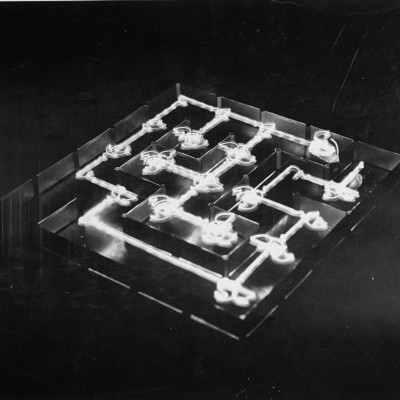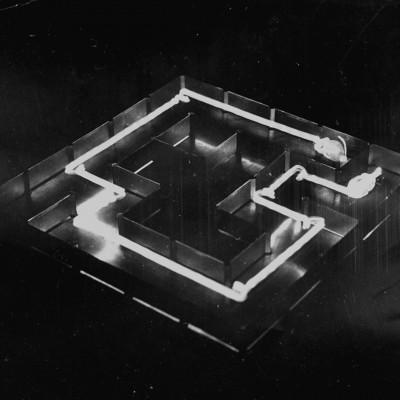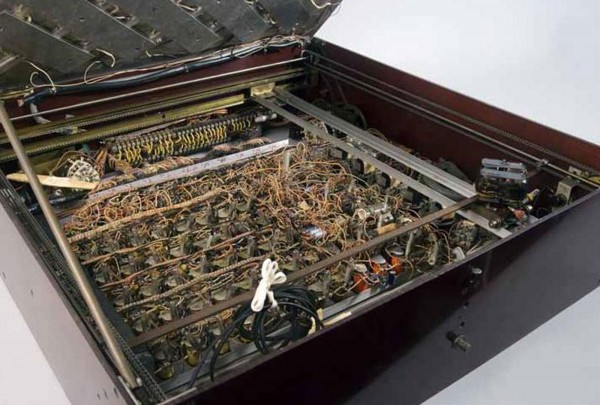Mighty mouse
https://www.technologyreview.com/s/612529/mighty-mouse/
Mighty mouse
In 1950, Claude Shannon cobbled together telephone circuits to build a machine that could learn.
In a grainy film shot at Bell Laboratories in 1952, mathematician and Bell Labs researcher Claude Shannon, SM ’40, PhD ’40, stands beside a machine of his own construction. First built in 1950, it was one of the world’s first examples of machine learning: a robotic maze-solving mouse known as Theseus. The Theseus of ancient Greek mythology navigated a minotaur’s labyrinth and escaped by following a thread he’d used to mark his path. But Shannon’s electromechanical toy was able to “remember” its path with the help of telephone relay switches.
As the film begins, Shannon’s wheeled mouse methodically explores its surroundings—a 25-square maze. Shannon tells viewers that the maze’s metal walls can be freely rearranged, so Theseus must use a small computing machine to learn the layout anew each time. But the mouse, a tiny wooden device containing a bar magnet and adorned with wire whiskers, is “far too small” to contain a computing machine, he says. Instead, the machinery is hidden beneath the floor of the maze, a series of telephone relay circuits he has repurposed to do something that they had never done before: learn.
Under the metal floor of the maze, an electromagnet mounted on a motor-powered carriage can move north, south, east, and west; as it moves, so does Theseus. Each time its copper whiskers touch one of the metal walls and complete the electric circuit, two things happen. First, the corresponding relay circuit’s switch flips from “on” to “off,” recording that space as having a wall on that side. Then Theseus rotates 90° clockwise and moves forward. In this way, it systematically moves through the maze until it reaches the target, recording the exits and walls for each square it passes through.


While Theseus works through the maze, the film cuts to other footage as Shannon talks about AT&T’s telephone network. A minute or so later, the viewer returns to the maze, where Shannon, holding the mouse in his hand, tells us that it has finished learning. Shannon places it back in the maze, and—once it’s released—Theseus and its embedded magnet are guided by the electromagnetic carriage along the pathway indicated by the relay switches left in the “on” position. In just 18 seconds, it scoots unerringly to the target, a brass piece of cheese that triggers a buzzer when touched by the copper whiskers.
Before working at Bell Labs, Shannon had already made his mark as a student at MIT, where he proved that Boolean logic could be applied to electronic circuits, a concept that would lay the groundwork for digital computing. The eminent cognitive scientist Howard Gardner would later call his 1940 master’s thesis, “A Symbolic Analysis of Relay and Switching Circuits,” “possibly the most important, and also the most famous, master’s thesis of the century.”
In 1948, Shannon had introduced the concept of information theory in “A Mathematical Theory of Communication,” a paper providing mathematical proof that all communication can be expressed digitally. The idea that information could be reduced to 1s and 0s was revolutionary in the 1940s, when large parts of the telephone system were still reliant on operators using manual switchboards to make analog, wired connections between phones. It was so revolutionary, in fact, that “there were a lot of people who did not agree with Shannon,” says Mazin Gilbert, vice president of advanced technology and systems at AT&T Labs. “They didn’t see the profound breakthrough that he had.” For decades, many doubted that communication could be all digital, and it took years before people started testing and understanding Shannon’s vision. “Even in the ’90s, scholars had a hard time understanding what Shannon was talking about,” says Gilbert. “He was multiple generations ahead of his time.”
Theseus was also ahead of its time, and it “inspired the whole field of AI,” says Gilbert. The mouse, which was featured in Popular Science, Time, and Life magazines the same year the AT&T film was made, learned purely through trial and error. “This random trial and error is the foundation of artificial intelligence,” Gilbert says.
By many accounts, Shannon was uncomfortable with his growing fame; he was reclusive during his time as a professor at MIT, mentoring only seven graduate students during his 22-year tenure. As for Theseus, several versions of the maze were built at Bell Labs for demonstration purposes, including the mirror-mounted machine in the 1952 video. While the original maze no longer functions, it remains part of the MIT Museum’s collection.
Shannon made the original Theseus maze at home, with the assistance of his wife, Betty, herself a mathematician at Bell Labs. “Did AT&T have a machine shop that could have built it for him? Yes. But he built it at home because he wanted to,” says AT&T historian Sheldon Hochheiser. “He liked to tinker, liked to build things … [it was] part of his genius.” But while he may have built it mainly for the fun of it, Shannon’s maze of self-learning, self-moving switches gave Bell Labs researchers a better understanding of the labyrinthian network of AT&T’s telephone switching system. In a written description of the project, Shannon noted that his machine was “capable of solving [by trial and error], remembering the solution, and also of forgetting it in case the situation changes and the solution is no longer applicable.” Insights gained from the Theseus project allowed AT&T to improve the mechanical memory and routing of its telephone network.

But not all Shannon’s contraptions had practical applications. “I’ve always pursued my interests without much regard for final value or value to the world,” he said in a 1992 interview. “I’ve spent lots of time on totally useless things.” He went where his inspiration took him, which was often to toys and games, including chess-playing machines, a Rubik’s Cube solver, gas-powered pogo sticks, and a machine that, when turned on, causes a mechanical hand to pop out of a box and turn itself off.
Shannon’s wry humor surfaces at the end of the Theseus film. He looks directly into the camera and notes that the method the mouse uses is mathematically guaranteed to “solve any possible maze.” And then, playfully, he traps the mouse in a single square.